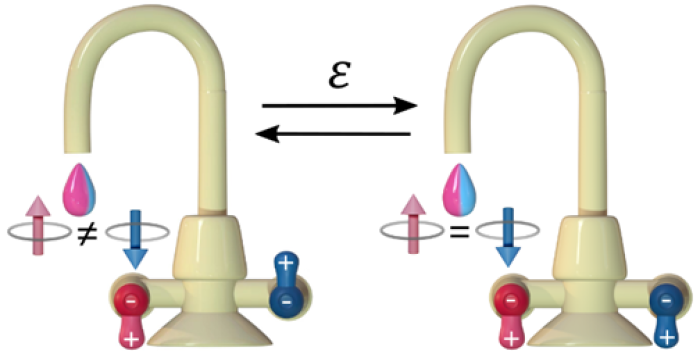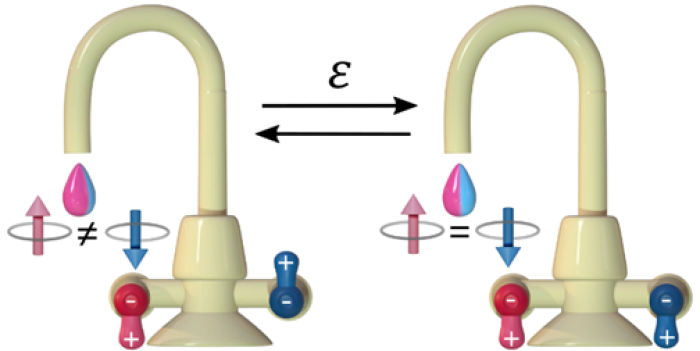Altermagnets That Turn On and Off
Altermagnets are arguably the hottest objects in magnetism right now (see Viewpoint: Altermagnetism Then and Now). Over the past year, researchers have delivered experimental evidence for this new type of magnet, but they have yet to harness the behavior for applications. Now three independent groups have proposed methods for electrically tuning the properties of altermagnets [1–3]. If implemented, the findings could allow the use of altermagnets in next-generation spintronics devices.
Altermagnets can be thought of as a cross between antiferromagnets and ferromagnets. Like antiferromagnets the materials lack net magnetization—the magnetic spins of the atomic lattice are aligned in opposing directions. Like ferromagnets they have magnetically sensitive energy levels and display electronic band structures that are split into spin-up and spin-down bands. This splitting can be used to polarize an electronic current, as one spin state will flow through the material more easily. The combination of these properties could allow researchers to create spintronics devices that operate more rapidly and with greater efficiency than those currently in use, but for that, they first need a way to manipulate the spin properties of an altermagnet.
The proposed methods of the three teams (a group led by Tong Zhou of the Eastern Institute of Technology, Ningbo, China; Libor Šmejkal of the Max Planck Institute for the Physics of Complex Systems, Germany; and a group led by Qihang Liu of the Southern University of Science and Technology, China) all use electric fields for this switching. Controlling magnetism with electricity is particularly attractive because electric fields are much easier to manipulate and integrate into modern electronic devices than magnetic fields. Electrical tuning is potentially also faster (subnanosecond) and could use less energy, two crucial properties for the development of high-speed, low-power spintronic devices.
Zhou and colleagues consider a so-called antiferroelectric altermagnet [1]. Like an antiferromagnet, an antiferroelectric material has within its atomic structure electric dipoles that are aligned in opposite directions. The team imagines a material in which these dipoles are coupled to magnetic spins in such a way that the spin-up population, or sublattice, is linked to the spin-down sublattice through a rotational symmetry. Such a material would display both antiferroelectricity and altermagnetism. However, applying a small electric field would cause the dipoles to line up in the same direction. In this ferroelectric state, the material would no longer be an altermagnet—it would switch to an antiferromagnet. As a result, it would no longer polarize an electronic current. “The electric field acts as a switch that toggles the spin polarization on and off, much like turning a spin faucet on or off,” Zhou says.
The groups led by Šmejkal and Liu consider a different system, a so-called ferroelectric switchable altermagnet [2, 3]. A ferroelectric, as the name implies, has electric dipoles pointing in the same direction. In this system, an applied electric field couples to deformation modes of the material to control the sign of the altermagnet’s spin splitting. For Šmejkal’s proposal this deformation comes from rotations of lattice units within the material that—when electrically activated—reverse the ferroelectric polarization of the system, a phenomenon dubbed the altermagnetoelectric effect. For Liu and colleagues, the relevant deformation is the so-called Jahn-Teller distortion, an alternating contraction and elongation of specific bonds. “In spintronic devices based on ferroelectric switchable altermagnets, controlling the spin degree of freedom becomes as straightforward as writing data to a solid-state drive,” Liu says.
“These findings are a significant step forward in understanding spin splitting,” says Sayantika Bhowal, a condensed-matter physicist at the Indian Institute of Technology Bombay. She says that these theoretical works demonstrate how electric fields might control spin splitting by altering the geometric environment around magnetic ions. “Since this control is achieved without disrupting the antiferromagnetic order, it opens up exciting possibilities for future research,” Bhowal says.
Danilo Puggioni, a computational physicist at Northwestern University, Illinois, agrees. “The concept of designing a multifunctional altermagnet, where an electric field controls spin-splitting, is both intriguing and promising,” he says. “From a technological perspective, the discovery of such a material could open pathways to more reliable and efficient memory devices.”
With the three theoretical frameworks established, the researchers are now hoping experimentalists will validate their theoretical proposals through experimental measurements. Zhou and colleagues identified several possible material families where the behavior could arise, including 2D van der Waals metal phosphates and 3D perovskite oxides. Meanwhile Liu and colleagues identified two ferroelectric-switchable-altermagnet candidates, and Šmejkal identified several more, including bismuth ferrite, the textbook example of a ferroelectric–magnetic combination.
Alexander Edström, who studies magnetism and magnetic materials at KTH Royal Institute of Technology, Sweden, expects that the three studies will quickly inspire experimentalists. But he cautions a demonstration may take some time. Puggioni notes that the proposed materials either lack the desired property at room temperature or have yet to be synthesized. “Unambiguously measuring the switching of the altermagnetic spin splitting may be experimentally challenging,” Edström says. “Finding new effects and techniques to directly or indirectly measure the phenomenon is another important point to consider in future work.”
–Katherine Wright
Katherine Wright is the Deputy Editor of Physics Magazine.
References
- X. Duan et al., “Antiferroelectric altermagnets: Antiferroelectricity alters magnets,” Phys. Rev. Lett. 134, 106801 (2025).
- L. Šmejkal, “Altermagnetic multiferroics and altermagnetoelectric effect,” arXiv:2411.19928.
- M. Gu et al., “Ferroelectric switchable altermagnetism,” Phys. Rev. Lett. 134, 106802 (2025).





